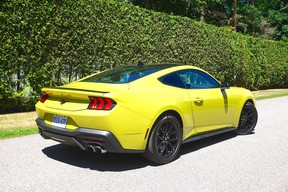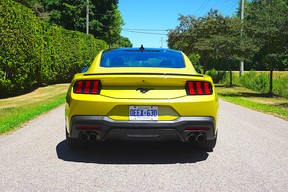Car Review: 2025 Ford Mustang EcoBoost | Reviews
More grand tourer than sports car, turbo four-powered pony car is still impressive

Article content
A Mustang without V8 power is not a Mustang. There, I said it, my line in the sand stretching back to the time I first laid eyes on Ford’s symbolic pony car 61 years ago, further cemented by pictures I drooled over — as a prepubescent car nerd — of the 1965 and ’66 Shelby GT350 variants, the then-ultimate in Mustang badassery.
Along with a trio of Fox-body 5.0-litre Mustangs my brother owned during the ’80s and ’90s, I have driven numerous V8 models over the decades; some four- and six-cylinder versions as well. Highlights include a sympathetically restored 1967 Shelby GT500 owned by the Hagerty insurance company and powered by a 355-hp, 428-cubic-inch (7.0L) eight and, at California’s famed Laguna Seca racetrack, a 2016 GT350R, replete with an oh-so-sweet 5.2L flat-plane crankshaft V8 that put out a high-revving 526 hp. (Should the opportunity arise to test the mega-pricy, barely street-legal 815-hp Mustang GTD, I would do so, provided I had a heart defibrillator standing by afterward, for I’m not getting any younger.)
However, there was a short time back in the mid-’80s that (choke, gasp) a four-cylinder Mustang caught my eye. It was the Mustang SVO, a project of Ford’s Special Vehicle Operations, powered by a turbocharged 2.3L four that put out 175 hp at first, and then 205 hp, this at a time when said turbo four could match the Mustang’s 5.0L V8 in output. The SVO had a different vibe to it, quasi-European sport coupe in nature. The thing that eventually killed it off after its short three-year-run was a significantly higher MSRP than the 5.0 Mustang, along with the fact Ford’s engineers kept upping the 5.0’s horsepower.
Some 40 years later, my attention is once again diverted from V8 revery, this time by the EcoBoost-powered Mustang. I drove one of the then-new seventh-generation pony cars a couple of years ago, labelling it “impressive,” the turbo four engine responsive and with a pleasing exhaust note. But that reaction was during its launch in California, meaning a compressed drive of a few hours. This time, I have a full week with the fastback coupe, giving me more of a chance to substantiate or modify that initial impression. Also confirming my fanboy appreciation of the 486-hp, 5.0L Coyote V8-powered GT, I wrote at the time of the launch: “If the EcoBoost impressed, the GT delighted,” the car accelerating “with verve” (a diplomatic way of saying it laid rubber when given serious throttle — its low 4s time to 100 km/h the better part of a second quicker than the EcoBoost).
2025 Ford Mustang EcoBoost fuel consumption
OK, then, I’m an unrepentant, old-school Boomer who likes the sound and fury of a V8 on a redline charge. That doesn’t mean the Mustang EcoBoost is a target for scorn nor bereft of charms, especially if greater fuel efficiency is a thing for potential buyers. According to Natural Resources Canada, the EcoBoost is rated at 10.8 L/100 km in the city, 7.1 L/100 km on the highway, and 9.2 combined, considerably thriftier than the automatic GT — 15.7/10.4/13.3 L/100 km. For what it’s worth, I averaged 8.2 L/100 km over 725 km, much of that on busy highway.
What powers the Ford Mustang EcoBoost?
Parsimony does not come at the expense of performance, meaning the Mustang EcoBoost is no slug, powered as it is by a 315-hp, turbo 2.3L four, mated to a 10-speed automatic — although only the autobox, as six-speed manual availability is the purview of the GT. One advantage is that the Mustang EcoBoost is lighter, with a curb weight of 1,628 kilograms (3,588 lbs.) for the Fastback model. Conversely, the GT, has a curb weight of 1,736 kg (3,827 lbs.) with the manual transmission, and a couple of kilos more with the automatic.
What competes with the Ford Mustang EcoBoost?
So, let’s alter the narrative, one that defines the Mustang EcoBoost not, like the GT or even more powerful, 500-hp Dark Horse, as the original rear-wheel-drive pony car with ballsy performance, but more as an affordable grand tourer, one that is still quick, agile and eye-catching. Since the Mustang has outlasted its direct competition from Detroit — fare-thee-well Camaro, so long Challenger — think instead sporty coupes, sedans and hatchbacks such as the Nissan Z, Toyota Supra and GR86, Volkswagen GTI and R, and Honda Civic Type R, to be among this Mustang’s potential rivals.
How much is the 2025 Ford Mustang EcoBoost?
With a base price of $44,580, the EcoBoost is a relatively cheap entry into the sporty car segment. The tester’s MSRP of $53,520 added $8,940 worth of options that dressed up the car to make it look jazzier and more distinctive (Mustang Nite Pony package, a can’t-miss-it-in-a-parking-lot Intense Lime Yellow metallic paint job, etc.) and add extra creature comforts (navigation, B&O sound system, Ford Co-Pilot360 Assist, and more), but other an upgrade from 18-inchers to P255/40R19 Continental rubber, nothing to make it perform any better.

That said, it doesn’t need much more. The 7th-gen’s launch two years ago had us blitzing the canyon roads of the Angeles National Forest where, slipping into Sport mode, we took to the twisting and undulating tarmac like Ethan Hunt on an impossible mission. One can quickly adjust steering effort, engine response, and transmission and electronic stability control settings through six available drive modes — Normal, Sport, Slippery, Drag (seriously?!), Track, plus a customizable setting with up to six individual profiles. In particular, the 10-speed autobox reconfigures its shift patterns to match the selected drive mode.
This time, the tester spent much of its time blitzing summer traffic on the perpetually busy 401, slotting into packs of vehicles clipping along at 120 to 130 km/h. Highway cruising is an easy environment for the largish two-door (4,811 mm in length), adjustments in speed easily accomplished either through a slight increase in throttle or a tap of the large disc brakes. The Mustang turns easily and with precision, albeit with a steering weight that still feels slightly over-boosted.
Credit where due, though, the EcoBoost engine has the sound of a much bigger motor, with a rich, throaty note from the quad tailpipes, thanks to the tester’s $1,545 active valve performance exhaust. The system, for those unfamiliar, uses an electric valve and two-part valve and actuator assembly to constantly open and close based on throttle inputs. By opening the valves farther than they would be with a stock exhaust setup, airflow is increased and back pressure reduced.
For those not who are not Mustang fanatics in general, or the seventh-generation pony car in particular, it looks a lot like the previous model, which is no bad thing. although a closer inspection of the newest edition reveals copious tweaks and tucks that freshen the car’s classic silhouette — long hood, sloped roofline, short rear deck. The Tri-Bar LED headlamps continue the Mustang’s classic lighting signature and the roofline, stance and shortened rear overhang are also reminiscent of the first generation’s profile. The extended rear deck houses the signature tri-bar lighting.
Whether you ascribe to Ford referencing the Mustang’s cabin as “fighter jet-inspired” or not, it is a busy place to hang out and play with buttons. In terms of passenger accommodation, the fastback has always been more of a 2+2 than a four-seater. Front-seat headroom is 955 mm (37.6 inches), 884 mm (34.8 in.) for anyone suffering in the rear seats. Front legroom is 1,130 mm (44.5 inches), while the rear seat is tight at 736 mm (29 in.).
The driver has two curved displays to look at, which can be customized to show information. The 12.4-inch digital instrument cluster is customizable to display different animated designs and drive-mode visuals. Settings can be adjusted by swiping the graphic to rotate the car virtually. From there, almost everything in the displays – and the ambient interior lighting – can be configured to selected tones, while instrument clusters adapt to drive mode selection.
Clearly trying to make the Mustang more appealing to a young audience, Ford removed most of the physical buttons, such as radio and climate controls, integrating them into a digital display, the company claiming that research showed this would be popular “with Millennials, Gen-Z and traditional Mustang drivers alike.” Uhm, speaking from an old fart traditional point of view, that would be a hard “no,” especially for the HVAC functions, which require diverting one’s eyes from the road to adjust the heat or fan. (Yeah, Consumer Reports didn’t like it much, either.)
Two other annoyances: The first is that the gear lever does not have a detent between Drive and Low, meaning, if one is not paying attention, shifting from Park or Reverse into Drive will instead find you in Low, accompanied by the disconcerting sound of an over-revving engine. The second is that the front seats, while initially seeming comfy and supportive, turned out to be a genuine pain in the lower back, experienced by both me and a buddy after a two-hour drive.
On the plus side, being long-legged, I appreciated the flat-bottom steering wheel, which provides more room when getting seated.

Final Thoughts
Pony cars, like automobiles in general, are an endangered species, a victim of consumer obsession with crossovers, sport-utes and pickups. So, kudos to FoMoCo for keeping the faith and not only sticking with Mustang for more than six decades but putting it out there as a significant player for hot-shoe aficionados both OG and younger. (OK, I struggle to say something complimentary about the Mustang II. And don’t get me started on the Mach-E, a decent EV that nonetheless should never wear the Mustang name.)
As for the EcoBoost, maybe it’s an age thing, but it does not give me anywhere near the same warm and fuzzy feeling the V8-powered GT engenders. Still, I have come to respect it. It provides a sophisticated, albeit less visceral, kind of dash and drama than the GT, doing so without a heart-stopping MSRP. It looks suitably boy-racerish, the tester particularly so kitted out with the Nite Pony package, bigger wheels and performance exhaust. The Intense Lime Yellow paint job is polarizing, though — most opinions were less than gracious.
In short, two years after my initial thoughts, the Mustang EcoBoost remains impressive.
Pros and cons of the 2025 Ford Mustang EcoBoost
Pros
✔ EcoBoost four-cylinder puts out good power
✔ Good handling dynamics
✔ Performance doesn’t come with a big price tag
Cons
✘ No manual transmission offered with EcoBoost engine
✘ No detent between Drive and Low
✘ Seats very uncomfortable on longer drives
Sign up for our newsletter Blind-Spot Monitor and follow our social channels on X, Tiktok and LinkedIn to stay up to date on the latest automotive news, reviews, car culture, and vehicle shopping advice.
























Postmedia is committed to maintaining a lively but civil forum for discussion. Please keep comments relevant and respectful. Comments may take up to an hour to appear on the site. You will receive an email if there is a reply to your comment, an update to a thread you follow or if a user you follow comments. Visit our Community Guidelines for more information.